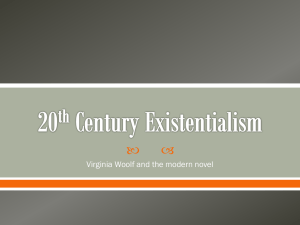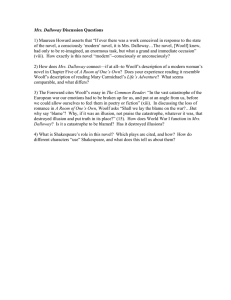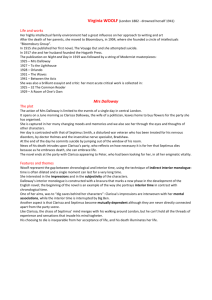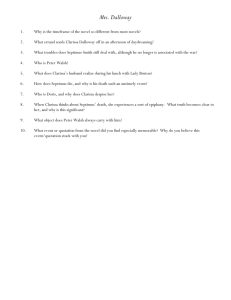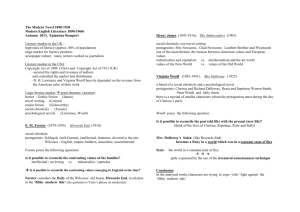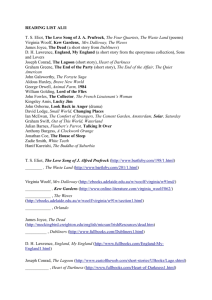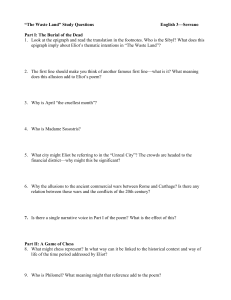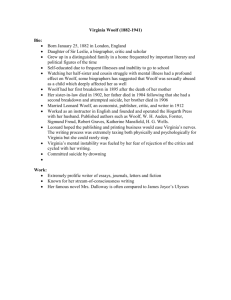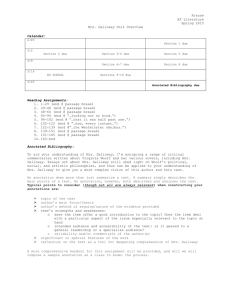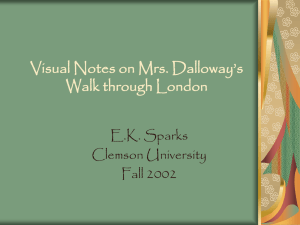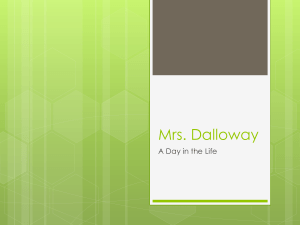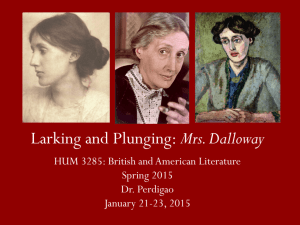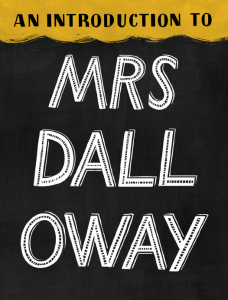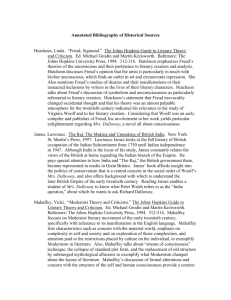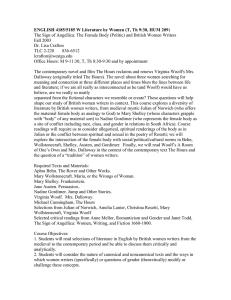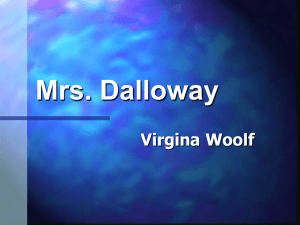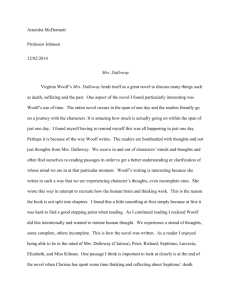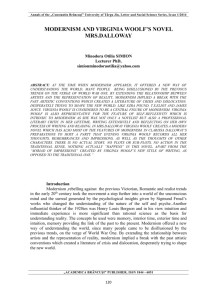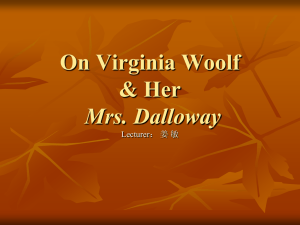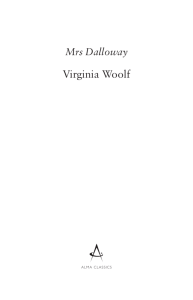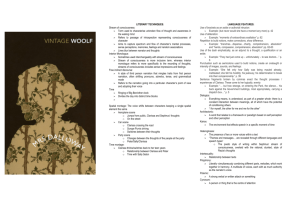Virginia Woolf, Mrs Dalloway (1925)
advertisement
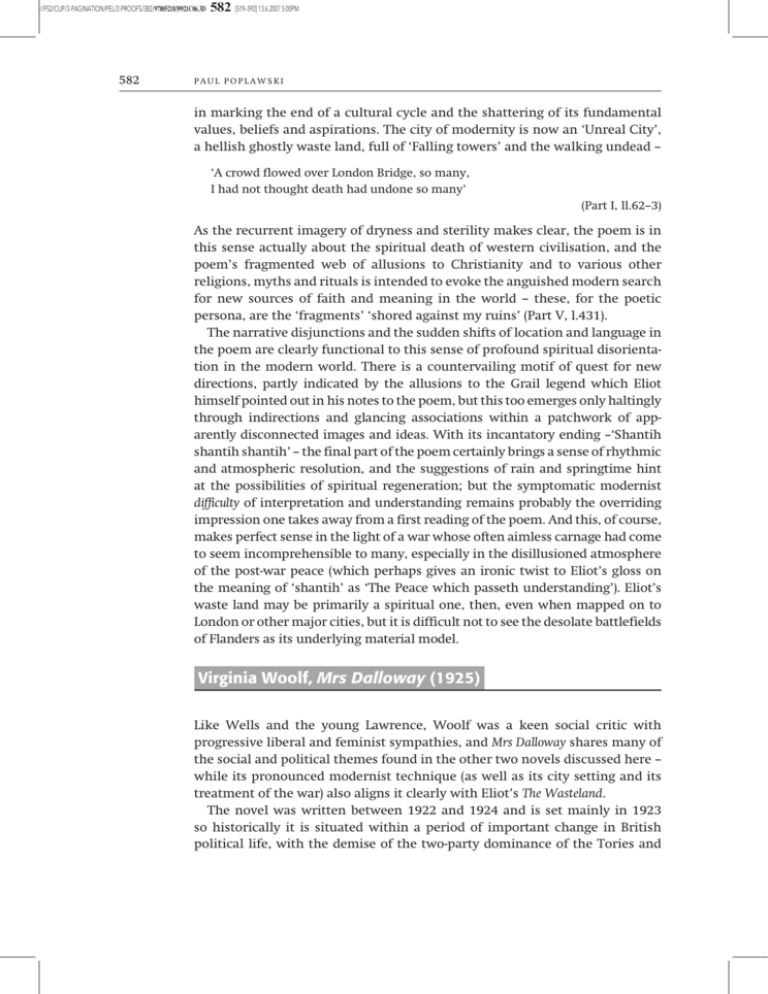
//FS2/CUP/3-PAGINATION/PEL/2-PROOFS/3B2/9780521839921C06.3D 582 582 [519–592] 13.6.2007 5:00PM PAUL POPLAWSKI in marking the end of a cultural cycle and the shattering of its fundamental values, beliefs and aspirations. The city of modernity is now an ‘Unreal City’, a hellish ghostly waste land, full of ‘Falling towers’ and the walking undead – ‘A crowd flowed over London Bridge, so many, I had not thought death had undone so many’ (Part I, ll.62–3) As the recurrent imagery of dryness and sterility makes clear, the poem is in this sense actually about the spiritual death of western civilisation, and the poem’s fragmented web of allusions to Christianity and to various other religions, myths and rituals is intended to evoke the anguished modern search for new sources of faith and meaning in the world – these, for the poetic persona, are the ‘fragments’ ‘shored against my ruins’ (Part V, l.431). The narrative disjunctions and the sudden shifts of location and language in the poem are clearly functional to this sense of profound spiritual disorientation in the modern world. There is a countervailing motif of quest for new directions, partly indicated by the allusions to the Grail legend which Eliot himself pointed out in his notes to the poem, but this too emerges only haltingly through indirections and glancing associations within a patchwork of apparently disconnected images and ideas. With its incantatory ending –‘Shantih shantih shantih’ – the final part of the poem certainly brings a sense of rhythmic and atmospheric resolution, and the suggestions of rain and springtime hint at the possibilities of spiritual regeneration; but the symptomatic modernist difficulty of interpretation and understanding remains probably the overriding impression one takes away from a first reading of the poem. And this, of course, makes perfect sense in the light of a war whose often aimless carnage had come to seem incomprehensible to many, especially in the disillusioned atmosphere of the post-war peace (which perhaps gives an ironic twist to Eliot’s gloss on the meaning of ‘shantih’ as ‘The Peace which passeth understanding’). Eliot’s waste land may be primarily a spiritual one, then, even when mapped on to London or other major cities, but it is difficult not to see the desolate battlefields of Flanders as its underlying material model. Virginia Woolf, Mrs Dalloway (1925) Like Wells and the young Lawrence, Woolf was a keen social critic with progressive liberal and feminist sympathies, and Mrs Dalloway shares many of the social and political themes found in the other two novels discussed here – while its pronounced modernist technique (as well as its city setting and its treatment of the war) also aligns it clearly with Eliot’s The Wasteland. The novel was written between 1922 and 1924 and is set mainly in 1923 so historically it is situated within a period of important change in British political life, with the demise of the two-party dominance of the Tories and //FS2/CUP/3-PAGINATION/PEL/2-PROOFS/3B2/9780521839921C06.3D 583 [519–592] 13.6.2007 5:00PM Twentieth century, 1901–1939: readings 583 Liberals and the coming to power for the first time ever of a Labour government (in January 1924). This context is evident within the novel in the satirical treatment of the British upper classes and, in particular, the governing classes as represented by characters like Richard Dalloway (a Conservative MP), Hugh Whitbread and Lady Bruton; and there is a stark critique of class inequalities in the contrasts between their pampered lives and the lives of characters like Rezia and Septimus Smith and the ‘degradingly poor’ Miss Kilman (p. 135). A whole host of other contextual issues are evident in the novel too. It reflects in close detail on the different social roles of men and women at the time, and presents a subtle analysis of gender differences in its carefully staged character contrasts and comparisons, celebrating in particular a feminism of ‘difference’ in the portrayal of Clarissa Dalloway, while also giving voice to equal-rights feminism through the figure of Sally Seton. Peter Walsh, just back from India, hints at contemporary debates about empire, and the narrative deals directly with the impact of the war, both through the nightmarish visions and ultimate suicide of the shell-shocked Septimus Smith, and through the contrasts between Clarissa’s (and Peter Walsh’s) pre-war memories of gentrified country life at Bourton and the changing social scene of post-war London in the novel’s present. General social and cultural transformations brought about by new technologies such as the car and aeroplane are registered too, perhaps most entertainingly at the start of the novel in the extended descriptions of the (possibly royal) motorcade (pp. 15–20) and the advertising aeroplane’s cryptic sky-writing (pp. 21–31); and there are frequent references to the mass media and to popular entertainment such as the cinema – indeed, the novel’s own technique has been described as cinematic in its use of flashbacks, shifting Changing conceptions of character and identity points of view, and montage-like cutNot only the conventions for representing character ting from scene to scene. had changed for Woolf’s generation, but also the very As with Lawrence’s The Rainbow, concept of character and personality. The human however, what is perhaps most dispersonality was not one given fixed monolithic entity, but tinctive about Mrs Dalloway, is its typia shifting conglomerate of impressions and emotions. cally modern psychological treatment Psychoanalysis was uncovering a multi-layered self, of character and consciousness. in which dreams, memories, and fantasies were as Woolf’s experiments in depicting important as actions and thoughts. Philosophers were describing the self as a receiver of a tumult of sensations. consciousness in fiction are rather Artists and painters were experimenting with versions different from Lawrence’s, though, of perception and reality. The Woolfs’ Hogarth Press and here the ‘stream of consciousbegan to publish Freud’s works in 1921, and although ness’ label is much more straightforshe was overtly dismissive of psychoanalysis, Woolf wardly applicable. Woolf’s previously developed her own acute psychological method of cited comments from her essay explaining sensation, memory and repression, one which ‘Modern Fiction’ effectively sum up resembles Freud’s in many respects and which uses a what is usually meant by the technisimilar model of the levels of human consciousness. (Elaine Showalter, ‘Introduction’, que: the ‘ordinary mind on an ordinary Mrs Dalloway, p. xviii [A]) day’ receives ‘a myriad impressions’
